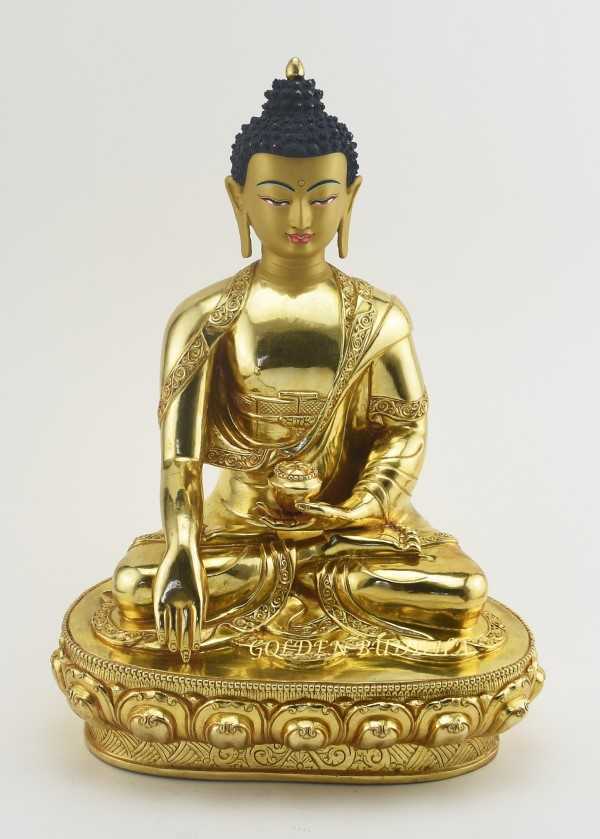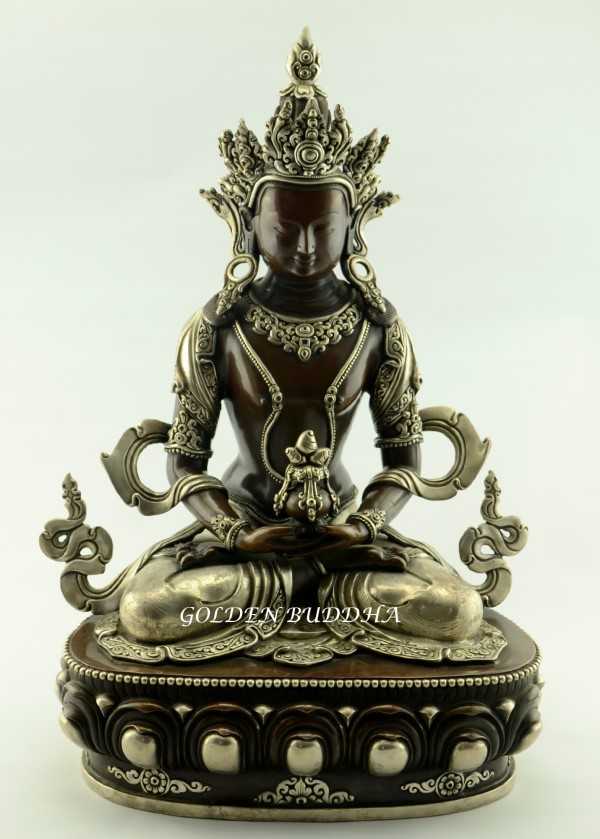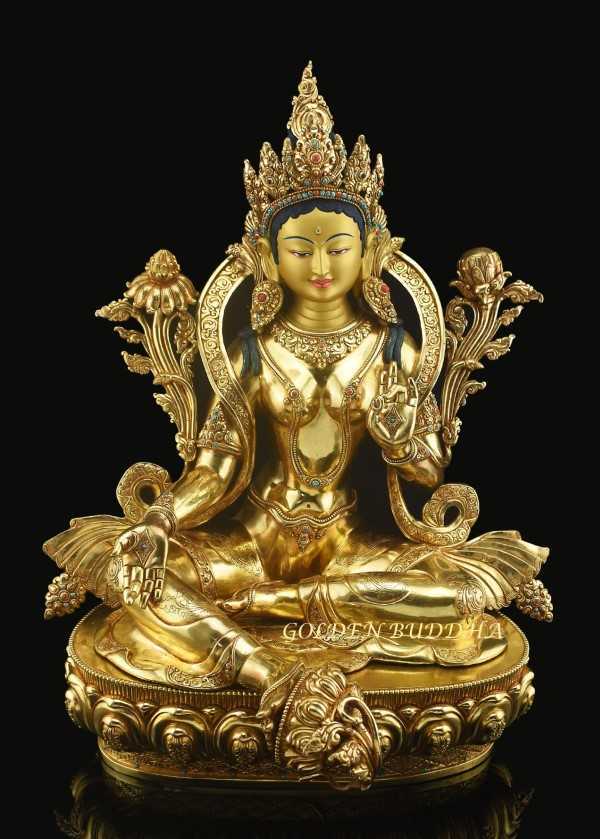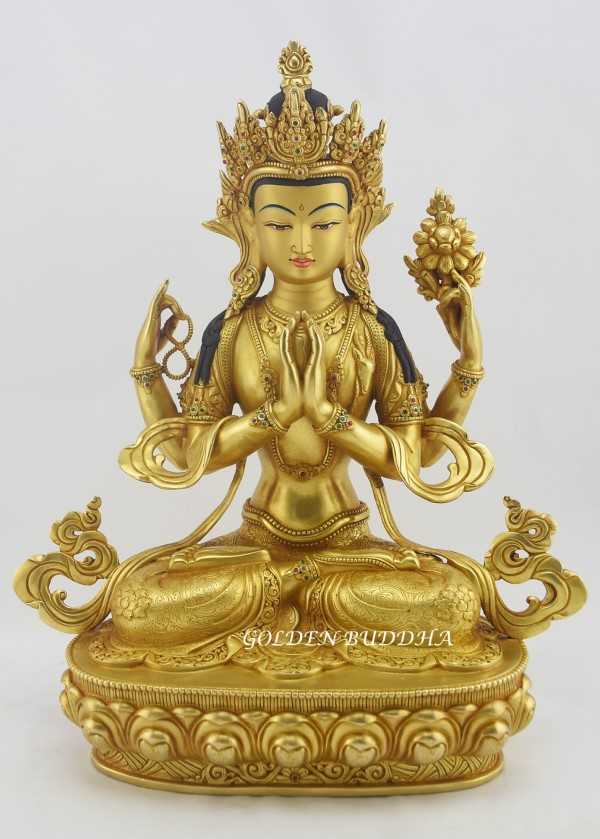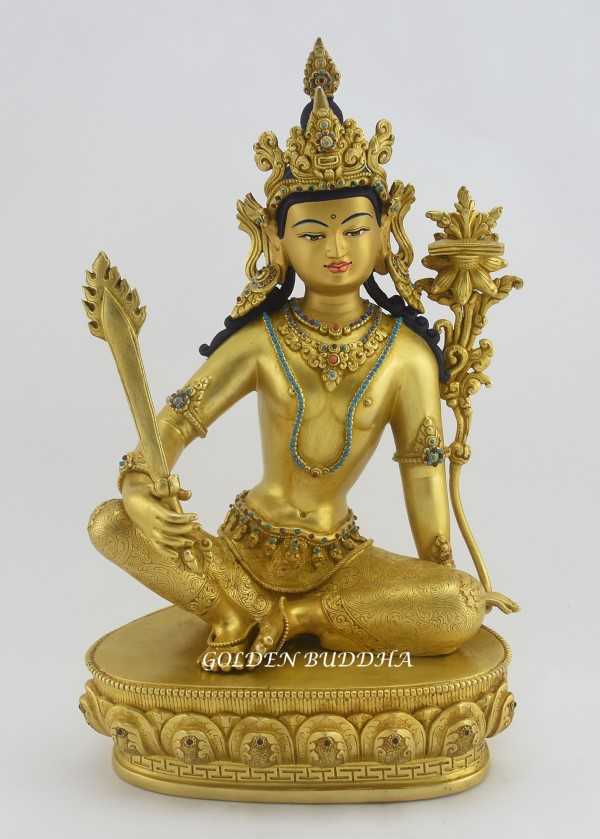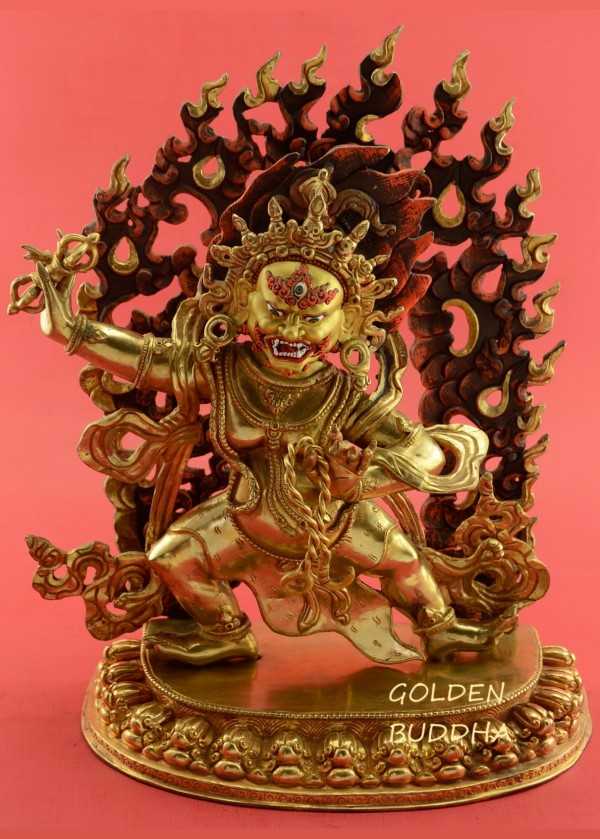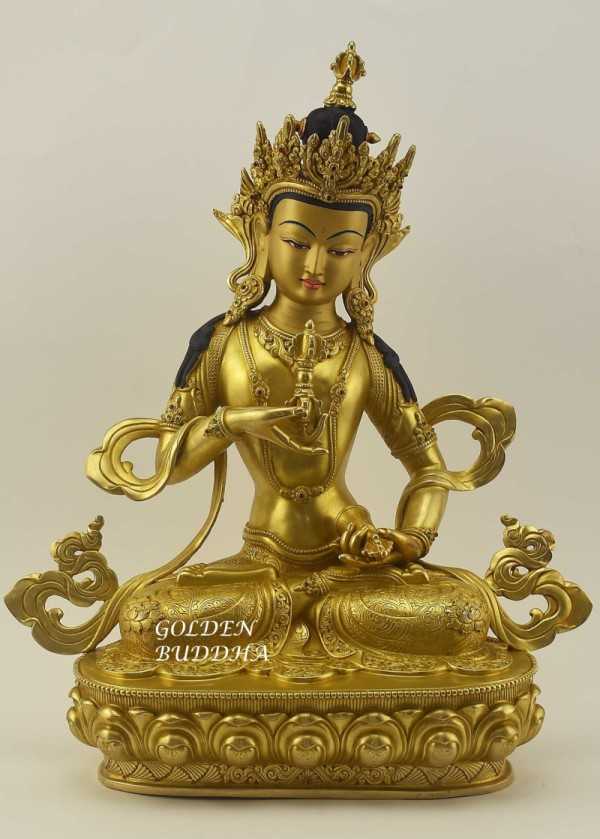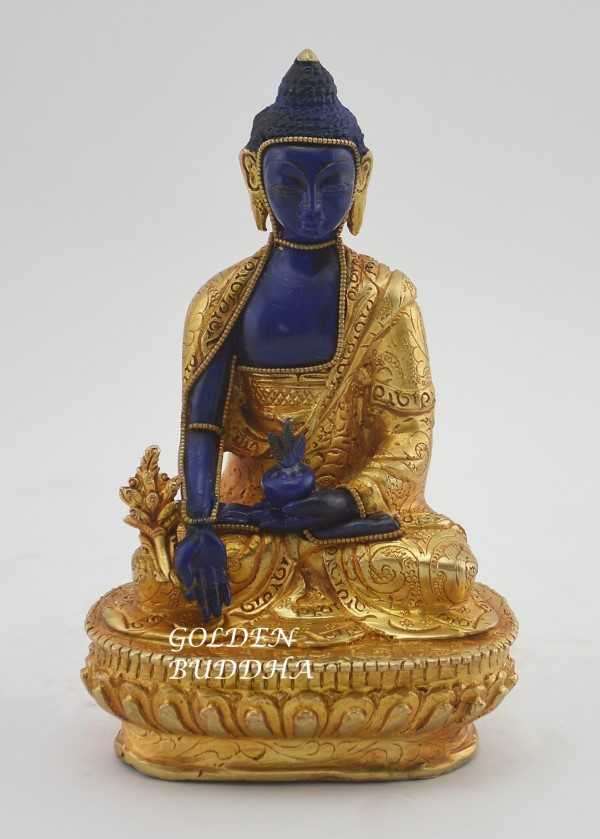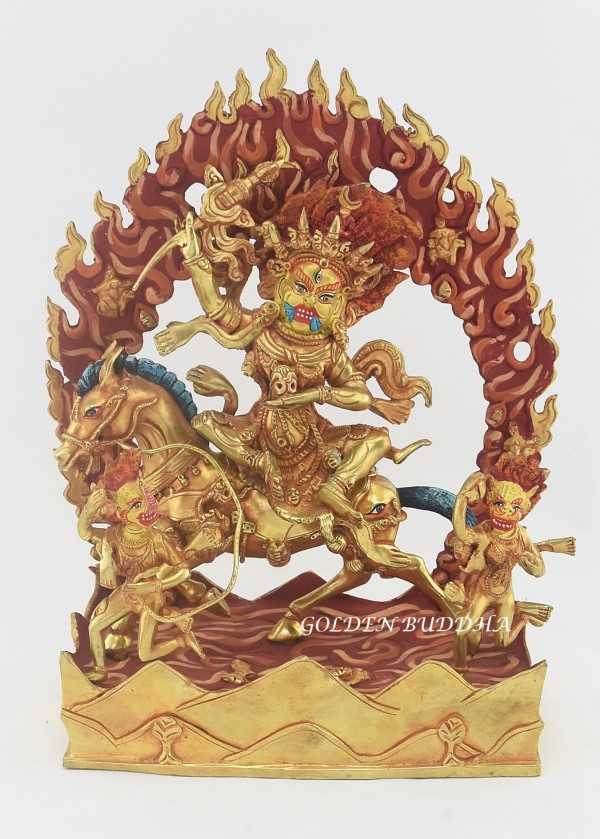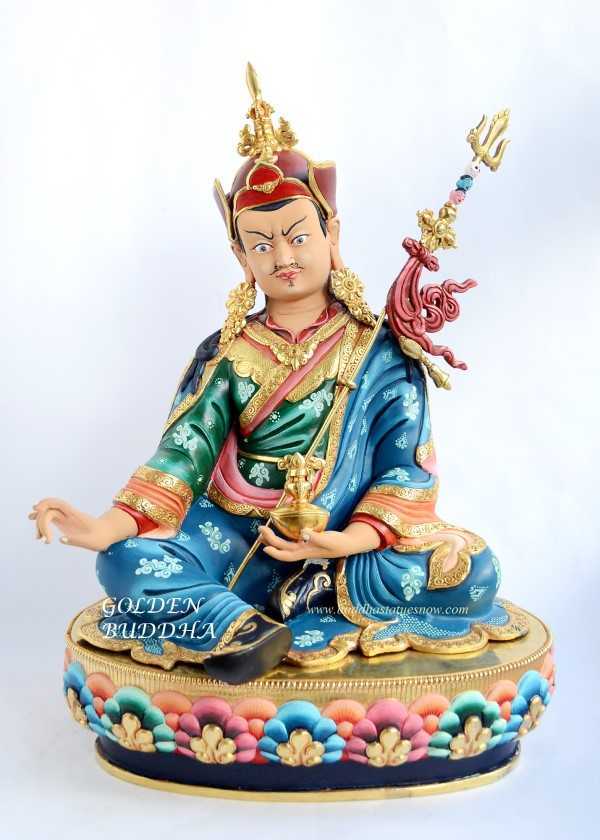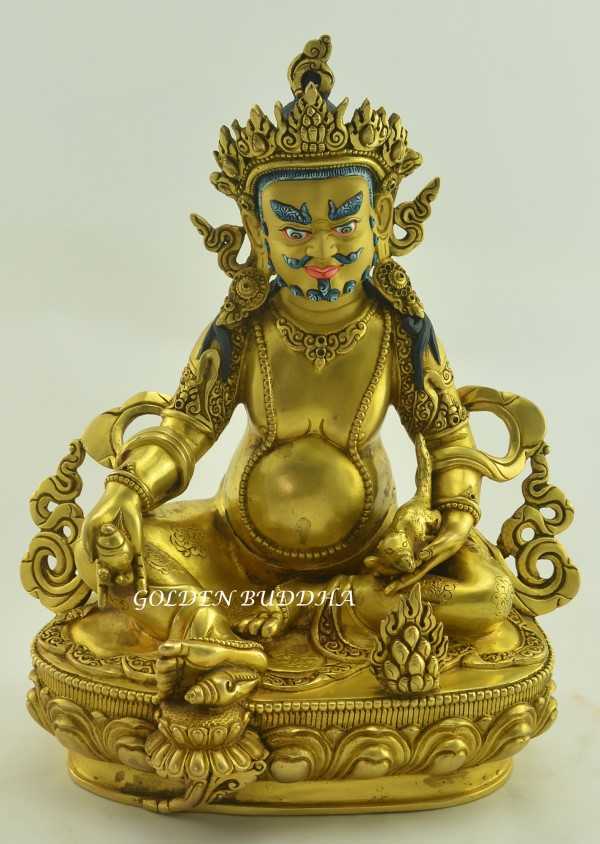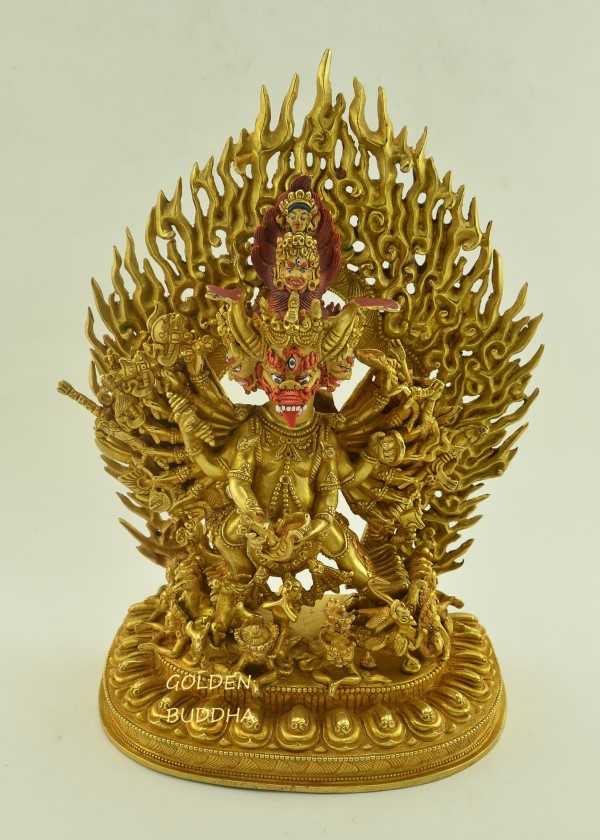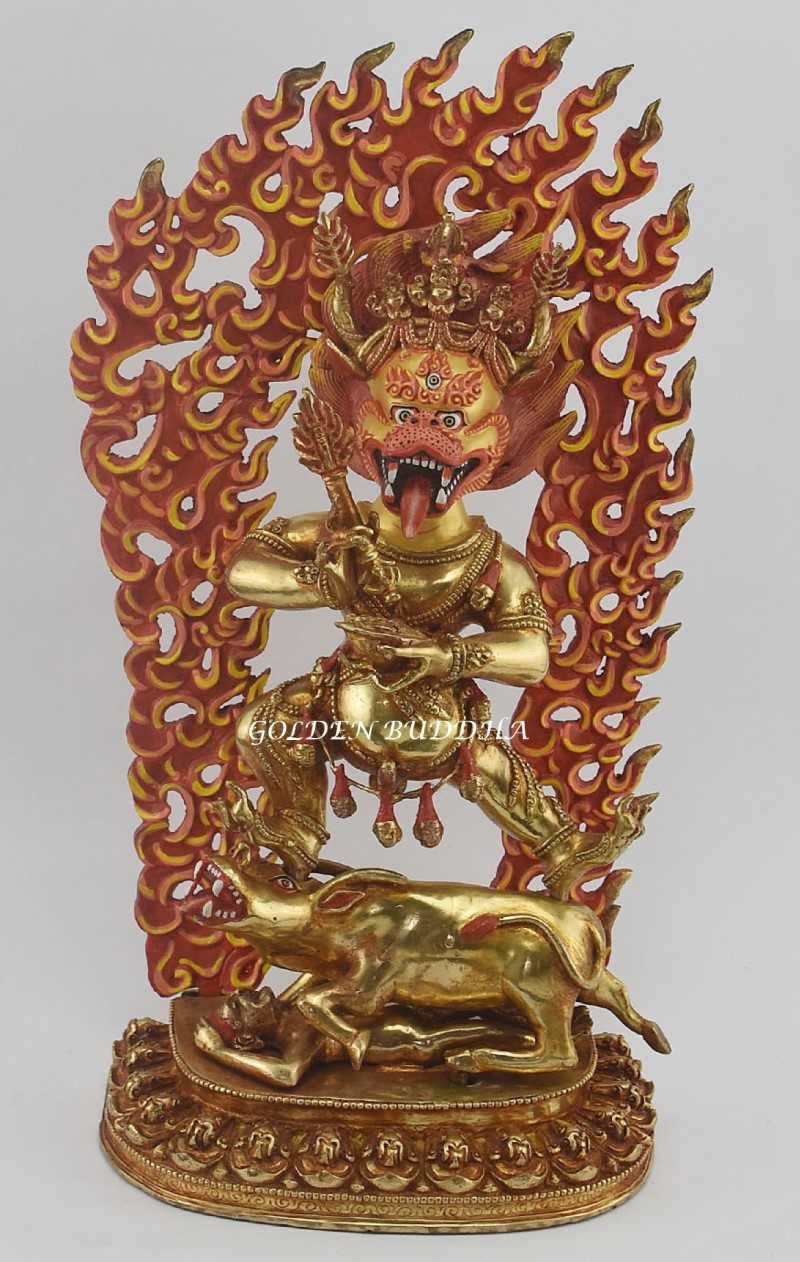Buddhist deities living in the 6 Buddhist realms of existence have different meanings, forms and origins. Indeed, these Buddhist deities along with Buddhas and Bodhisattvas have always existed throughout the 6 realms of existence and thousands of world cycles.
The most commonly found statues of the Buddhist deities venerate gods, Buddhas and high level Bodhisattvas. However, astute practitioners of Buddhism must ask themselves if Buddhas and Bodhisattvas are actually gods? Many people incorrectly assume that they are.
Generally speaking, there are several types of divinities who inhabit the spheres above and below the human realm. The most powerful are the gods e.g. Devas and Brahmas. Other divinities such as nagas, kinnaras and garudas can be found in the human realm.
Finally, the guardian deities (Dharmapala) can dwell in the upper realms but also in hell. Although Dharmapala are actually Buddhas or Bodhisattvas that have taken different forms, so they are not actually Buddhist gods. Read more below to find out why.
Top Buddhist Deities List:
- Gautama Buddha (The Buddha)
- Amitabha Buddha (Infinite Light and Life)
- Amitayus (Infinite Life)
- Green Tara (Protection)
- Avalokiteshvara (Compassion)
- Manjushri (Wisdom)
- Vajrapani (Power)
- Vajrasattva (Karma Purification)
- Medicine Buddha (Healing)
- Palden Lhamo (Guardian of Tibet)
- Guru Rinpoche (Founder of Tibetan Buddhism)
- Jambhala (God of Wealth)
- Yamantaka (Destroyer of Death)
- Yama (Lord of Death)
Who are the Real Buddhist Gods?
- Devas and Brahmas – heavenly beings that exist in five main heavens that are structured in layers above the human realm. They can exist in material or immaterial form.
- Nagas – are semi-divine beings who exist in the form of snakes and they can take human form. Nagas are associated with bodies of water such as lakes and rivers.
- Kinnaras – mythical half human, half bird creatures that come from the Himalayas and assist humans in times of trouble. They are in a perpetual state of bliss and are always dancing and singing.
- Garudas – the garudas are giant birds who are enemies of the nagas and are often depicted grasping a snake in their claws. They have limited divine characteristics and some can take human form if necessary.
- Dharmapala – this is a Sanskrit word that translates literally as “Protector of the Dharma”. Dharmapala are actually Buddhas or Bodhisattvas that have taken the form of fierce protectors of the faith e.g. Yamantaka.
False Assumptions about Buddhist Gods
What many people think are gods are not really “Buddhist gods” at all. Some Bodhisattvas are highly venerated by devotees but they are not gods or Buddhas. Indeed, Avalokiteshvara has taken a vow of compassion to remain in the cycle of samsara and assist sentient life.
A high profile example would be the Dalai Lama who Tibetan Buddhists believe is an incarnation of the Bodhisattva of Compassion – Avalokiteshvara. Although the Dalai Lama has certainly achieved a god like status, he is neither a god or a Buddha. The Dalai Lama is a Bodhisattva.
Furthermore, in more progressive Buddhist schools, Buddhas and Bodhisattvas are imbued with special god like powers. For example, an embodiment known as “Sambhogakaya” enables Buddhas and Bodhisattvas to appear at anytime, as anything, anywhere.
This Sambhogakaya embodiment can be peaceful, semi-wrathful or wrathful. Attributes of this embodiment enable the Buddha or Bodhisattva to heal sickness, purify karma and grant long life.
However, these powers would be considered controversial to conservative Buddhists. Indeed, the progressive Buddhist schools have drifted far from what the Buddha actually taught.
Buddhist Gods Have Human Frailties
The Buddhist gods along with Bodhisattvas still exist in the cycle of rebirth known as samsara. As a result, these deities have the same frailties as humans such as sensuous desire, conceit and emotion. The Buddha, who has eliminated all traces of these mundane frailties, reigns supreme.
Furthermore, since they are still trapped in Samsara, their rebirth can occur in the human realm. If so, they would need to start over and accumulate enough merit to return to the heavenly realms. Indeed, only a fully fledged Buddha has transcended the cycle of rebirth.
Theological Origin of Buddhist Gods
The three primary variations of Buddhism are Theravada, Mahayana and Vajrayana (Tibetan Buddhism). Additionally, beliefs and practices of each denomination range from very conservative to extremely progressive. However, even the most conservative Theravada Buddhist must acknowledge the existence of gods.
Indeed, the Buddha’s own mother ascended to the Tusita heavenly realm after her death (Realm of the Gods). Plus, thousands of Devas and Brahmas attended the Buddha’s first sermon when he set the “Wheel of Dharma” in motion. The existence of these Devas and Brahmas is evidenced in the most venerable and original teachings of the Buddha such as the Dhammacakkappavattana Sutta and the Bhavacakra.
So this is the million dollar question – Can the Buddhist gods perform miracles? The answer would vary between Theravada, Mahayana and Tibetan Buddhist doctrines. No, possibly and yes – respectively.
What would the Buddha say about Buddhist Gods?
The orthodox teachings of Theravada Buddhism would consider the concept of Buddhist gods and Bodhisattvas to be irrelevant regarding personal salvation.
This is very significant because Theravada Buddhism (also known as Hinayana), is what the original Buddha taught his disciples. The Buddha said:
“One’s own karma is one’s own property.”
Shakyamuni Buddha
Therefore, it is a settled matter that your salvation is in your own hands and no miracle can save you from yourself. As a result, the only way to correct a person’s bad karma is to replace it with good karma.
Progressive Schools of Buddhism
However, in Mahayana and Tibetan Buddhism there is a much greater acceptance of Buddhas and Bodhisattvas possessing divine powers. As a result, their devotees are much more sympathetic to the concept of miracles.
Therefore, Mahayana Buddhists would take an approach that would help devotees help themselves, so to speak. But Tibetan Buddhism is much more progressive, with sufficient faith, devotees can induce outright miracles from the Tibetan gods.
This would include karma purification, wealth creation, longevity and bending an estranged lover or even a king to your will.
How do you Pray to “Buddhist Gods”?
Buddhist miracles are more likely when the devotee is also living a virtuous lifestyle. As a result, Buddhists follow the precepts in combination with prayer, performing acts of generosity and meditation practice. The five Buddhist precepts include abstaining from:
- Harming other sentient life forms
- Improper sexual acts
- Speaking untruths
- Taking what is not given
- Consuming intoxicants.
Furthermore, most Buddhas and Bodhisattvas have a mantra which devotees recite in order to gain their favor, the more recitations the better. Many devotees also make offerings on the altar of the deity, such as food.
Members of the Buddhist Pantheon
The statues listed below will include a brief description, mantra, historical origin and also an image of the Buddha, Bodhisattva or Dharmapala referenced.
For devotees, an image of the Buddhist deity is important in some form such as a sculpture or painting. Having a physical representation your spiritual inspiration in your home, meditation room or on your altar will increase the effectiveness of your practice. This is because the virtues the deity represents can strongly influence your future actions for the better and help you to purify karma.
The Buddha
Shakyamuni Buddha Mantra
(Tibetan Buddhism)
“Om Muni Muni Maha Muniye Soha”
Is Shakyamuni Buddha the ruler of the Buddhist Gods? As discussed above, the short answer is yes, although he is not considered a Buddhist god. Instead, Shakyamuni Buddha is best described as the Buddha of our time.
Shakyamuni Buddha was reincarnated in the 6th century BCE as the Prince Siddhartha Gautama. He was born in Northern India (present day Nepal) and his father was King Suddhodana and his mother was Queen Maya. Additionally, he was the only child after 20 years of marriage and Queen Maya proclaimed that it was an immaculate conception.
To the dismay of King Suddhodana, Prince Siddhartha renounced his claim to his father’s kingdom when he was 29 years old and set out to end all suffering. 6 years later at the age of 35 years, he became a “Buddha” which is a Pali term for “all knowing or awakened one”.
From that time forward he was known as “Shakyamuni Buddha” or “Gautama Buddha” and dedicated the remaining 45 years of his earthly life to teaching the Dharma path.
Furthermore, Shakyamuni Buddha is considered to be a Sammasambuddha. This is because he rediscovered the Dharma completely on his own and reintroduced in an era where it had been long forgotten. As a result, he is similar to his predecessor Dipankara Buddha and also his successor – Maitreya – who is prophesied to be the future Buddha.
Amitabha Buddha “Infinite Light and Life”
Amitabha’s Mantra
“Om Amitabha Hrih”
Amitabha is known as the “Buddha of Infinite Light and Life.” As a Bodhisattva named Dharmakara he accumulated an infinite amount of merit during thousands of Bodhisattva lifetimes. Additionally, he is the central figure in Pure Land Buddhism and he has his own pure land called “Sukhavati”.
To gain admittance to Sukhavati, Amitabha asks his devotees to recite his name or mantra. As a result, they are able to enter his land of sonorous and visual bliss.
Once they gain admittance to Sukhavati, they will be protected and nurtured until they are to able to obtain the highest achievement of Nirvana.
Amitayus (Long Life Deity)
Aparmita Mantra
“Om A Ma Ra Ni Dzi Wan Ti Ye Soha”
Aparmita (also known as Amitayus) represents the longevity attribute of Amitabha Buddha. In Sanskrit, the Amitayus meaning translates as “infinite life”. Additionally, Amitayus practice is commonly performed in Tibet in the hopes that he will prolong the lives of devotees.
Buddhist deities statues of Aparmita statues feature his immortality vessel filled with “amrita”, the sacred elixir of immortality and awakening. A replica of his immortality vessel is filled with consecrated wine and it is the centerpiece of the longevity ritual. After the Amitayus practice is performed devotees each drink some of the consecrated wine and also consume some small pills made of dough.
It is believed that the effectiveness of the ritual depends on the faith of devotees in the longevity powers of Amitabha. Therefore, if the ritual is not effective it is blamed on a lack of devotion.
Green Tara (Protection Deity)
“Om Tare Tuttare Ture Svaha”
Green Tara is the most popular Buddhist goddess and she features first and foremost among all of the female Mahayana Buddhist gods. Indeed, Green Tara is only one of the 21 emanations taken by the Bodhisattva Tara. However, she embodies the most popular virtues of Tara and is therefore most highly venerated in Buddhist beliefs.
Tibetan Buddhists believe that Tara was born from a teardrop which fell from the eye of Avalokiteshvara. When Tara’s tear fell from his eye it landed in a lake filled with his tears and formed a lotus on the surface, from which Tara sprang forth.
Tara is also an ardent feminist and she has refused reincarnation as a male until there are more female Buddha names. However, the facts about of Green Tara fluctuate among the different Buddhist schools. For example, in Tibetan Buddhism she is already considered to be a full Buddha. However, in Mahayana Buddhism she is a Bodhisattva.
Green Tara is the Buddhist goddess of the forest and she lives in her pure land called – Mt Potala. Mt Potala is a lush forest wonderland with waterfalls, birds, flowers and trees. Additionally, the color green is affiliated with speed and agility. This is because Green Tara is always ready to assist devotees.
Avalokiteshvara (Bodhisattva of Compassion)
Avalokiteshvara Mantra
“Om Mani Padme Hum”
Avalokiteshvara (also known as Chenrezig) is an embodiment of the Buddha’s compassion. As a result, Avalokiteshvara has chosen to indefinitely delay his entrance into Nirvana until universal cessation of all suffering is achieved.
Upon realizing the immensity of his vow, it is believed that Avalokiteshvara imploded into thousands of pieces. Amitabha Buddha pieced him back together again so he would be better prepared to accomplish the task at hand. This is how Avalokiteshvara became the Buddhist god with many arms.
In fact, some depictions of Avalokiteshvara have 1000 arms and others are limited to 2 arms. Additionally, he is sometimes depicted with 11 heads so he can better hear and see the suffering of all sentient beings. Until his goal is achieved he will serve to fill the gap between Shakyamuni Buddha and the Buddha of the future – Maitreya. Indeed, Avalokiteshvara is the most venerable and well known of all Mahayana Buddhist gods.
Manjushri (Wisdom Deity)
Manjushri’s Mantra
“Om A Ra Pa Tsa Na Dhih”
Manjushri is venerable and time tested Bodhisattva in the pantheon of Buddhist gods. The most common depiction of Manjushri shows him wielding the sword of wisdom over his right shoulder.
Manjushri is believed to represent the Buddha’s wisdom. The power of wisdom is used to gently annihilate ignorance and delusion so practitioners can achieve spiritual realization.
Although he is wielding a flaming sword, the death of ignorance will be non-violent. Indeed, wisdom can outsmart ignorance and it will be a painless death conducted with surgical precision. Therefore, the flaming sword is a symbol of effectiveness, but not the means.
Manjushri resides in his pure land of Vimala which is believed to have a terrestrial presence on Mt Wutai in northern China. As a result, it is possible for worldly beings to visualize Manjushri as he sits in his earthly bodhimanda.
The recitation of Manjushri’s mantra is believed to enhance speech, increase memory capacity and sharpness of mind. The origins of Manjushri lie in the Prajnaparamita Sutta and he is quite popular with intellectuals.
Vajrapani (Power)
Vajrapani’s Mantra
“Om Vajrapani Hum”
Vajrapani represents the Buddha’s power of wisdom. Additionally, Vajrapani is one of the Buddhist guardian deities and also protector of the Buddha.
Indeed, Vajrapani is believed to have protected the Buddha (Prince Siddhartha) during his renunciation and he also helped him escape from the palace. After his escape, the Buddha would go on to became the founder of Buddhism.
Vajrapani can take a peaceful, semi-wrathful or wrathful appearance. In Tibetan Buddhism, Buddhist guardian deities are wrathful and used as meditation deities. Additionally, Buddhist deities statues often include Vajrapani depicted alongside Manjushri and Avalokiteshvara. Collectively, they represent the Buddha’s wisdom, power and compassion.
Vajrasattva (Karma Purification)
6 Syllable Mantra
“Om Vajrasattva Hum”
According to the Mahayana Buddhist texts there are three forms (bodies) that Buddhas and accomplished Bodhisattvas can take. These three bodies are known as the Trikaya which consist of Dharmakaya, Sambhogakaya and Nirmanakaya. The Dharmakaya is the body of truth, Sambhogakaya is the body of limitless form and the Nirmanakaya is the Buddha’s physical body as he would appear in the human realm.
Vajrasattva is believed to be an embodiment of Sambhogakaya that is used by the Primordial Buddha – Vajradhara. Theoretically, he can take any form imaginable. These forms can be something sublime such as a clear light manifestation. However, he can also appear as a one of the Buddhist guardian deities such as wrathful Vajrapani. Vajrasattva endeavors to appear in a manner which best appeals to his audience and his objective.
In Tibetan Buddhism, Vajrasattva is considered to be one of the Tibetan gods capable of purifying karma. Additionally, Vajrasattva has vowed to forgo enlightenment until those who have recited his mantra receive complete redemption from sin.
Medicine Buddha (Healing)
Medicine Buddha Mantra
“Om bhaiṣajye bhaiṣajye bhaiṣajya-samudgate svāhā.”
Medicine Buddha emerges in the 7th century ACE in the eponymous Medicine Buddha Sutra. Also known as Bhaisajyaguru, Medicine Buddha is one the most popular deities on the Mahayana Buddhist gods list.
The Medicine Buddha is easily recognized by his enigmatic deep blue color. Indeed, the Medicine Buddha himself is the color of the gemstone called lapis lazuli and many Buddhist deities statues of Medicine Buddha are blue in color. Additionally, the ground in his eastern Pure Land is also composed of the lapis lazuli and his Pure Land is called “Lapis Lazuli Pure Land”.
As a Bodhisattva, the Medicine Buddha made 12 great vows in the Medicine Buddha Sutra. These vows promise to cure all illness and every imaginable type of mundane suffering. The only requirement is for devotees to hear his name or recite his mantra. As a result, he is very popular with devotees and testimonies abound regarding miracle cures.
Palden Lhamo (Guardian Deity of Tibet)
Palden Lhamo Mantra
“JO RAMO JO RAMO JO JO RAMO TUNJO KALA RACHENMO RAMO AJA DAJA TUNJO RULU RULU HUNG JO HUNG”
In a former life, Palden Lhamo was a Sri Lankan queen named Remati. However, her husband the king was extremely hostile to Dharma practitioners. Despite her persistent warnings his persecution of Buddhists continued.
Queen Remati was furious and she vowed to destroy the king and his lineage. She carried out her threat by killing their son and flaying him while the king was out hunting.
Afterwards she fled on the back of a mule that was gifted to her by the gods. She used her son’s flayed skin as a saddle and rode to Siberia across a sea of blood through India, Tibet, China and Mongolia.
After her death she was reborn in hell but she escaped and emerged in the charnel grounds where Buddha Vajradhara appeared to her and suggested she become a Buddhist goddess of protection – Dharmapala. She agreed and she has since become the patron deity of the Gelug sect of Tibetan Buddhism. Additionally, she is the protector of the Tibetan government.
Palden Lhamo resides in her mountain home outside Lhasa, Tibet where she is the guardian spirit of the sacred lake Lhamo La-tso.
Guru Rinpoche (Founder of Tibetan Buddhism)
Here is Guru Rinpoche, an enigmatic figure who is highly venerated as the founding father of Tibetan Buddhism. He is also widely known as Padmasambhava which translates as “lotus born”.
In Northern India, Guru Rinpoche developed a reputation as being very persuasive in the spiritual realm. As a result, he was called to Tibet in the 8th century to assist with the establishment of the first Buddhist monastery.
Afterwards, Guru Rinpoche stayed in Tibet at the request of the Tibetan king. Over time, his Tantric Buddhist teachings were chosen by the Tibetan king over the sutra teachings of Santaraksita. As a result, Guru Rinpoche is believed to be a second Buddha and he is the founder of the Tibetan Buddhism.
Jambhala (God of Wealth)
Yellow Dzambhala Mantra
“Om Jambhala Jalendraye Svaha”
Dzambhala is known as the Buddhist god of wealth. Additionally, he is also one of the eight Buddhist guardian deities that have been given the mandate of protecting the Dharma.
The main focus of Dzambhala is to alleviate poverty. Most certainly, devotees would be better able to practice the Dharma if their most basic needs were met. Additionally, the eradication of poverty would eliminate the need for desperate action to relieve hunger and disease. As a result, practitioners would not feel compelled to commit theft or violence in order to survive.
There are five Dzambhalas and they are all members of the jewel family. Furthermore, the most popular Dzambhala is Yellow Dzambhala and he is an emanation of Buddha Ratnasambhava. Indeed, Ratnasambhava holds the virtue of equanimity which makes Dzambhala well suited for the task of eradicating poverty.
One of the most common features of Dzambhala statues is the mongoose that is perched on his left forearm. This mongoose is named Nehulay and he is always spitting forth precious jewels and treasures.
Yamantaka (Destroyer of Death)
Yamantaka Mantra
“Om chu-li ka-la-lu-pa hum-kan so-ha”
Yamantaka is a combination of the words “Yama” which means “Lord of Death” and “antaka” which means “destroyer”. Combined, the meaning of Yamantaka is “Destroyer of Death”. Indeed, he is one of the most powerful of the Buddhist guardian deities. However, it is not immortality that he has achieved, instead he has broken the cycle of rebirth – samsara.
Yamantaka is the most misunderstood of all the Buddhist Guardian deities. Indeed, he has nine heads with the head of a water buffalo at the center. The horns create an image westerners would perceive as Satan. In fact, his appearance is so demonic, the first Christian missionaries to Tibet believed Tibetan Buddhism was a form of devil worship.
However, Yamantaka is a wrathful embodiment of the Buddhist God of wisdom – Manjushri. Therefore, his appearance belies the fact his origin lies in sublime wisdom. To understand Yamantaka, you must understand the concept of “fight fire with fire”. The concept is very powerful and sometimes the best way to break the illusion of self is to counter it with a more powerful illusion.
The Mythical Origin of Yamantaka
In Tibetan Buddhist beliefs, there is an ancient myth that explains the origin of Yamantaka and the end of existence (suffering). Long ago in ancient Tibet, the Yama – Lord of Death – appeared and was killing the people throughout the country. As a result, Tibetans prayed to their most powerful Buddhist God – Manjushri – to come and save them from the Yama.
Manjushri responded by taking a more ferocious appearance than the Yama. He appeared with nine heads, 32 hands holding weapons and 16 legs to trample on negativity. Additionally, he stood within a the flames of pristine wisdom that protected him from all negative thoughts.
Using the image of Yamantaka, Manjushri defeated death (cycle of rebirth) to enter the realm of supreme enlightenment – he became a Buddha. As a result, in Tibetan Buddhist beliefs, Manjushri is a Buddha. However, in Mahayana Buddhism Manjushri remains a high level Bodhisattva.
Yama “Lord of Death”
Yama is the Sanskrit word for “Lord of Death”. The Yama is also the Buddhist God of Death and the keeper of the Hell Realms. The origins of the Yama are in ancient Tibet; where from inside the cave of a hermit monk arose this ferocious lord of the Buddhist Hells.
The Story of the Yama
The origins of Yama are told in a story which goes like this: while the monk was deep in meditation, two thieves burst into the monk’s cave with a stolen bull in tow. Deeply disturbed, the monk became angry because he was on the verge of spiritual realization before the intruders entered the cave.
The monk told them to leave the cave but after many refusals the monk became very angry. Thinking that the monk would betray them to the authorities and they would be caught, the thieves cut off the head of the bull and the also monk. However, the monk did not die.
Since the monk had been a high level practitioner of special siddhis, he was able to arise from death in anger and placed the severed head of the bull on his shoulders. While wearing the head of the bull, he killed both of the thieves and went on a murderous rampage throughout the Tibetan countryside. The people were very fearful and referred to him as the “Lord of Death” – Yama.
The rampage of the Yama continued until Manjushri came to the rescue in the form of “Yamantaka” (see above). Yamantaka is the “Destroyer of Death”.


